Minivans used to be hugely popular because they were hugely practical. Which may explain why minivans have become less popular than they used to be.
Because they are very curiously less practical in one very popular respect.
Almost none of them offer all-wheel-drive anymore.
Except for this one
The Sienna is a 7-8 passenger full-size minivan in the same class as rivals like the Honda Odyssey, Kia Sedona, Dodge Caravan (and its Chrysler-badged twin, the Pacifica).
Prices start at $31,115 for the base L trim with front-wheel drive.
AWD is offered optionally with the LE, SE and top-of-the-line Limited Premium trims, in either 7 or 8 passenger seating configurations.
A top-of-the-line Limited Premium with AWD and captain’s chairs (seven passenger seating) stickers for $48,890.
WHAT’S NEW
The Sienna’s AWD system is now available with the sportier SE trim – which is the model you’ll want if you want a minivan suitable for vehicular wet work. This one gets a 19-inch wheel/tire package and firmer suspension calibrations, just the tools for doing un-minivan things (and getting away with doing them).
In addition to AWD, another feature that’s unique to the 2019 Sienna is the availability of built-in Alexa, Amazon’s artificial intelligence Oz that you can voice command to look up stuff online, play music and so on.
AWD Sienna has snow-day capability its rivals do not offer.
Sporty SE is more than sporty trim. This variant has a handling advantage over other minivans.
Quick. The result of having almost 300 horsepower under its hood; the Sienna may be a minivan – but don’t let that fool you.
WHAT’S NOT SO GOOD
AWD not available with the lower-priced L trim; you have to buy the more expensive LE ($33,935 to start) first and then buy the AWD version ($36,475).
Eight passenger seating also requires stepping up to the LE or higher trims.
Kia Sedona and Dodge Grand Caravan may not offer AWD but both cost about $4k less to start and offer similar size/room for people and cargo.
Turbo fouring has not come to minivans – yet.
It probably will, soon.
But for for the present, you can still get an appropriately sized (and not turbo’d to make up for too-small a size) 3.5 liter V6 in the Sienna.
It’s standard and it makes a class-best 293 horsepower – edging out the Honda Odyssey’s 3.5 liter/ 280 hp V6, the Grand Caravan’s 3.6 liter/ 283 hp V6 and the Kia Sedona’s 3.3 liter/ 276 hp V6.
All of these V6s – just for the record – make more horsepower than the V8s that came in most Mustang GTs and Camaros back in the ‘90s. 
This minivan – which weighs easily 1,000 lbs. more than a Mustang or Camaro and carries twice as many people, plus their stuff – also gets to 60 in just over 7 seconds. That’s about as quick – or quicker – than almost every “fire breathing” V8 muscle car of the ’60s.
It’s a measure how good we’ve got it today.
Family haulers that haul!
Toyota even made a slammed/lowered/road-racy one-off show-car version of the Sienna to showcase what could be done. ave a look: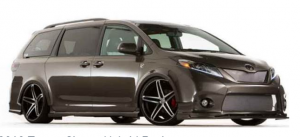
The Sienna’s V6 (which it shares with the Camry and Avalon sedans) is paired up with an eight-speed automatic transmission and your choice of standard front-wheel-drive or the optional all-wheel-drive system.
Which is one more choice than the FWD-only competition offers.
Ground clearance varies – depending on trim. The sporty SE – which comes with low-profile 19-inch tires as well as firmer suspension tuning – rides closer to the ground, with 6.2 inches of clearance.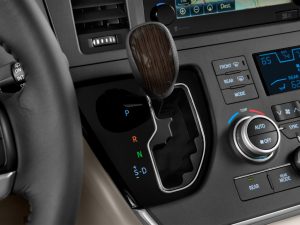
Other versions of the Sienna have 6.5-6.6 inches of clearance.
The AWD-equipped SE is the way to go for handling – a criteria one does not normally associate with minivans, but ought to in the case of this minivan.
The other, higher-riding trims with AWD are of course the way to go in the snow.
There is a mileage penalty to be paid for the additional bad-weather traction (or handling advantage) of the Sienna’s available AWD system, but it’s slight: 18 city, 24 highway vs. 19 city, 27 highway for the FWD version of the Sienna.
The FWD-only Kia Sedona rates exactly the same 18 city, 24 highway as the AWD-equipped Sienna.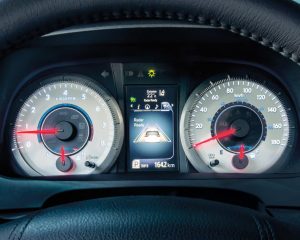
The best of the bunch – the Honda Odyssey – manages 19 city, 28 highway, a negligibly better 4 or so MPG overall. And to get there, the Honda uses a more complicated ten-speed automatic transmission (shared with the new Accord sedan) while the more conservatively engineered Sienna uses a simpler eight-speed automatic.
Which may also be why the Toyota out-tows the Honda by 500 pounds (3,500 lbs. max vs. 3,000 for the Odyssey).
Given that tow ratings tend to err on the conservative side – for warranty claim reasons – it gives some insight into Honda’s confidence in the durability under duress of the new ten-speed box.
Interestingly, the Dodge Grand Caravan tows the most – 3,600 lbs. – and it uses an even simpler six-speed transmission.
Also of interest, the GC’s mileage (17 city, 25 highway) is only slightly lower than the best-in-class Odyssey’s. This tells a tale of diminishing returns.
The mileage gains – ten speed vs. eight speed vs. six-speed – are slight but the increase in complexity to get them isn’t. The Odyssey’s ten-speed automatic has three overdrive gears (the Sienna’s has two, the Dodge’s just the one).
Programming a triplicate overdrive transmissions to shift up and down over such a wide spread of gear ratios without lugging the engine or other unpleasantness – is a major engineering (and software tuning) challenge.
And the benefit to the owner is . . . questionable.
Remember – maybe 4 MPG. Probably less.
So, why?
Because of Uncle’s insistence that new cars achieve ever-higher MPGs – no matter what it costs us to achieve them.
The Sienna – like all current minivans is big: 200.6 inches end to end, which is only about three inches less than a full-size SUV like the Chevy Tahoe, which is 204 inches long.
So there’s no getting around how much space it needs curbside or in your garage. But even though it’s about the same overall size as a full-size SUV, it’s easier to maneuver into either space because most of its length is in the middle – between the front and rear axle centerlines.
The driver sits much farther forward – almost cab forward, much closer to the front wheels. There’s less hood in front of him because the Sienna’s engine is mounted transversely (sideways) rather than longitudinally (front to back) as in a big SUV.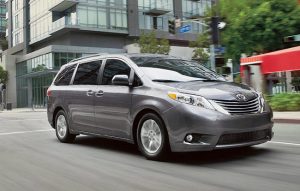
You thus have a better sense of the vehicle’s proportions when maneuvering in close quarters and the actual maneuvering is more adroit because the Sienna’s turning circle is tighter than a big SUV’s – 37.5 feet vs. 39 feet for the Chevy Tahoe. You also have a great canopy of glass all around, which gives a minivan like the Sienna something all-too-many new cars haven’t got anymore, regardless of their physical size:
Excellent peripheral visibility.
It’s easier to get in and out of minivans, too.
They have car-like step-in height, so no running boards, milk crates or grab handles are needed to climb aboard – as you often do need with today’s jacked-up SUVs and crossover SUVs, which emulate the SUV look, including their jacked-up stance.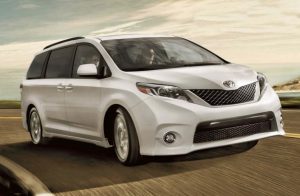
Once inside, you still sit up higher than you do in most cars – another visibility boon.
Minivans have a reputation for being road toads. This is very dated information. The Sienna is quicker than most crossovers and quick enough to keep up with most V8 SUVs. The difference between 7 seconds to 60 and 6 seconds to 60 (the time of the 5.3 V8-equipped Tahoe) is . . . one second.
Count it out.
If you were to drag race the two, the Tahoe would be about half a length ahead at the end of the 0-60 run. If you are faster-reacting to the green light, you can make that up and beat the Tahoe to the next light.
Regardless, he’s not going to walk away from you – unless you let him.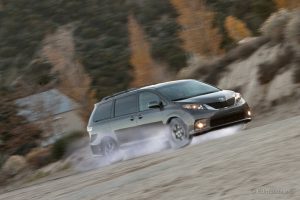
And in the curves, the Sienna will walk away from the Tahoe and lots of others, too. Remember, it’s much lower the ground than a jacked-up SUV (especially the Sport trim, which has about the same ground clearance as many sport sedans) which is a help – and the AWD is a definite handling advantage on dry/wet paved roads – which 4WD is not.
Truck-type 4WD is designed (usually) to be off when driving on smooth/paved roads; it is meant for traction in snow and mud – not grip in the curves.
Finally – and may the Motor Gods bless Toyota for this – the Sienna is not (yet) afflicted with the obnoxious auto-stop start system almost all new cars, crossovers, trucks and SUVs now come with as standard equipment.
The Sienna’s V6 only starts – and stops – when you push the ignition button.
Space efficiency is a minivan thing.
At 200.6 inches long overall, the Sienna is about 3.5 inches less long overall than a full-size SUV like the Tahoe. But it has 36.3 inches of legroom for its third row passengers – vs. 24.8 inches in the Tahoe. That’s the difference between a third row that’s for kids-only and a third row that can actually be used by adults.
The rows are also more accessible, because of the low step-in hight and the dual sliding doors on either side. It is much easier to climb into a minivan’s third row row than it is access the third row of anything with conventionally opening doors or the second row only.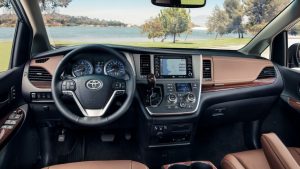
Like the other minivans, the Sienna can be ordered in seven or eight passenger seating configurations; the second row has almost two feet (23 inches) of fore-aft adjustability and tip/fold, too. Eight passenger models have a stowable center section.
Total cargo capacity is 150 cubic feet (first and second row seats no in use) which is hugely more than the 94.7 cubic feet in the Tahoe, with its second and third rows folded.
It’s also more total capacity than the next-best Odyssey (144.9 cubic feet), third best Kia Sedona (142 cubic feet) and the fourth place Dodge Grand Caravan (140.3 cubic feet).
You can even get a 4×8 sheet of plywood inside the Sienna – and it’s easier to get it in the Sienna (and back out, when you get home) because of the van’s lower cargo floor and (vs. truck-based SUVs like the Tahoe) wider-opening rear liftgate.
Some neat Sienna features include a button to the left of the steering wheel that lets you turn off the power assist for the sliding doors. This is helpful for people who don’t need help opening the sliding doors – and prefer the faster manual operation of yanking them open and slamming them home using muscle power – but still have the option to go power-assist for family members not as strong-armed.
Toyota also offers a voice-amplification system – Driver Easy Speak – that broadcasts the driver’s vice through the Sienna’s speakers to the kids (or whomever) back in the third row, eliminating the need to yell to get their attention.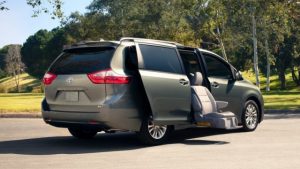
And for 2019, the Sienna (along with the 2019 Camry) offers Alexa, the same basic thing you can get for your house but now in your van.
The rearseat entertainment system (single 16.4 inch widescreen) can stream two different videos at the same time from the Internet via Bluetooth’d devices or Blu-Ray/HDMI inputs.
You can also order a factory-installed chair lift system.
THE BOTTOM LINE
Minivans are supposed to be practical – and this one is more practical than the others.
It’s also more fun.
But you don’t have to tell anyone about that!
. . .
Got a question about cars – or anything else? Click on the “ask Eric” link and send ’em in!
If you like what you’ve found here please consider supporting EPautos.
We depend on you to keep the wheels turning!
Our donate button is here.
If you prefer not to use PayPal, our mailing address is:
EPautos
721 Hummingbird Lane SE
Copper Hill, VA 24079
PS: Get an EPautos magnet (pictured below) in return for a $20 or more one-time donation or a $5 or more monthly recurring donation. (Please be sure to tell us you want a sticker – and also, provide an address, so we know where to mail the thing!)
My latest eBook is also available for your favorite price – free! Click here. 


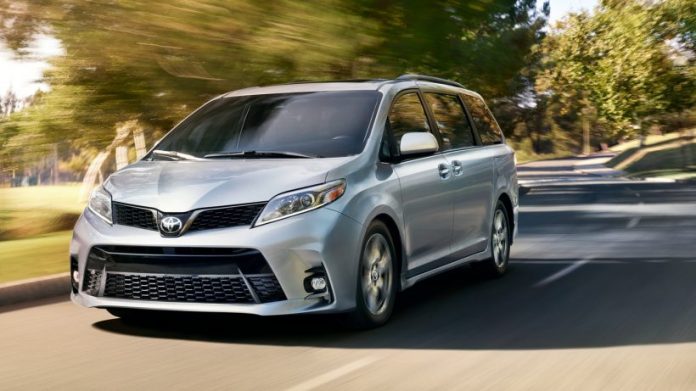

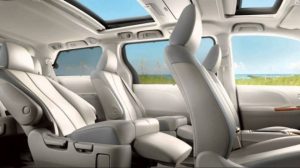
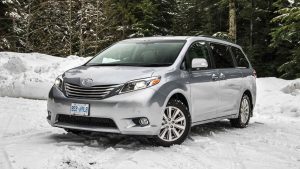

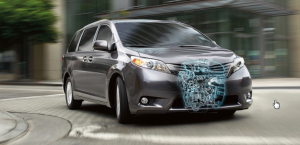









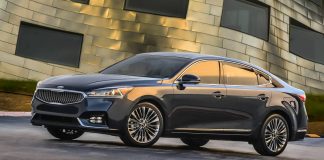
Alexa, what is the estimated time I have until your wifi radio waves have given me cancer and other illnesses?
Hi World,
At least it’s optional… for the moment!
I rented one of these a few years ago when visiting relatives in SoCal when they were “just” 266hp and was shocked how fast it was and well in handled. It was an education for me as I drive mostly older vehicles.
Re-acclimating to SoCal traffic where everyone drives 80+mph on the highway I punched it when merging on the freeway after leaving the airport, focusing on finding a space/spot to smoothly merge only to look down at the speedo after I settled into a spot in traffic to notice it was done close to 110mph…lol…the wife and kids had no idea either. It makes my wife’s LT1 engined Roadmaster Wagon feel like a fat pig.(still not trading it in though, I have a budget to keep…lol)
Hi Nick!
Yup! My ’76 Trans-Am was the most powerful – and quickest – American car available in 1976. Even quicker than the Corvette – because the biggest engine in the Corvette that year was a 350 and the Pontiac came with a 455… and 200 horsepower. That was a big number in ’76, believe it or not.
Anyhow, the TA made it to 60 in about the same 7 seconds as this minivan…
> Minivans have a reputation for being road toads.
Parents need more kids like this:
https://www.youtube.com/watch?v=Jh3d_Qo3jTI
The minivans are not the problem. Even the Chrysler vans from the early 90s with the V6 could really haul ass, as I did with one across the southwest USA. It’s the idiotic parents, who think the planet must come to a halt so their precious child (to them, not to us), can cross the road without having to use a brain.
“Interestingly, the Dodge Grand Caravan tows the most – 3,600 lbs. – and it uses an even simpler six-speed transmission.”
It doesn’t need more than those 6 gears to tow. The change in RPMs between most of those gears, right around 0.69, is almost exactly the change between the RPMs at peak torque, 4400, and the RPMs at peak HP, 6400 RPMs.
https://www.caranddriver.com/dodge/grand-caravan/specs
Some aspy engineer really thought about how to optimize those gear ratios.
“There is a mileage penalty to be paid for the additional bad-weather traction (or handling advantage) of the Sienna’s available AWD system, but it’s slight: 18 city, 24 highway vs. 19 city, 27 highway for the FWD version of the Sienna.”
So the AWD isn’t much better on gas than a newer full size 4×4 pickup ???
All that low CG and low ground clearance is just the thing that makes it worthless for us where we live. The county has succeeded in grading just about all of the gravel off into the ditches.
HP, as even with most of the new citified 4wd pickups, it’s only useful on pavement and the driveways the illegals have already cleaned.
Not that we have snow a lot, unlike those places that do and often deep, like the occasional blizzard we have, I’ve had to shovel out old high clearance 4wd pickups or walk back to the house and get the tractor or hope someone with better sense finds you in their tractor.
Don’t depend on that neato tow strap either. Count on that big chain….or two, you carry in the toolbox all year.
Those rubber booted half axles don’t take too well to mud, either.
Good morning eric from cold and wet west Texas….and we need the rain. Even the cousin in Palmdale is getting rain for the first time in 2 years.
Assessing the difference in AWD and 4WD, have you never tested a Tahoe or Z 71 with the Auto mode? I think 99 was the first year for this feature but for sure in 2000 and later.
It’s really the ticket for slick mud doing a better job than 4wd. I wouldn’t order a pick-up with it since I prefer a shifter but it does work well.
I wouldn’t race a minivan or anything else with my Z71 since it’s the most evil handling pickup I’ve owned. My one ton 4wd extended cab long bed diesel would handle circles around it. Even so the owners manual says auto mode transfers power around as needed.
If I toted a lot of passengers I’d consider a Sienna if there were no dirt roads involved. Since the only direction you have vision in the Sienna is straight ahead I can understand buying a crew cab pickup or a Suburban instead. Of course this is coming from a guy who grew up riding in the back of a pickup on long trips. We didn’t think twice about throwing a mattress in the back and a tarp over a livestock hauling set up or inside a camper shell for a 300 mile ride.
My my, ain’t we all some rarified wusses now?
I miss sitting in the back of the bed at 60mph on a county hwy when i was only 9. I think part of it is letting the women getting control of all the rules. My wife would never let my son sit in the back of a pickup no matter the age. I let my boy steer the car while i controlled the pedals when he was only 2. That’s the difference between men and women. The government is not big brother its big mother now.
Minivans although expensive now (except for the Dodge caravan and pacifica) are a great deal compared to CUV’s. CUV’s usually have 2 rows and top out higher or as high as the minivan with less cargo space, less motor, less legroom. People don’t know what they are missing.
Even their minivan is getting sporty. But yet, they pull out of racing video games because they don’t want a boy racer image anymore. Methinks Toyota is very confused right now.
Hi Chuck,
Every car company lives in fear of offending some SJW/PC sensibility – and finding themselves the target of a juggernaut of negative media coverage. I personally think they all ought to grow a pair and – like Trump – either ignore them or dismiss them for the frauds they are. But corporations have become both timid and cynical. They prefer not to rock the boat – and to make as much money as possible, even if by leveraging government force (e.g., “safety” equipment, EVs).
This will be their undoing.
Plus, it still offers that great minivan feature. Drop the rear seats flat, and when the economy crashes, you can live in your van Down By The River.
“Alexa, what’s my drive time to the nearest charity soup kitchen?” 🙂